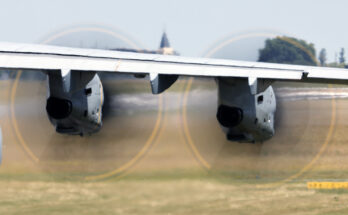By Ray Jaworowski, Senior Aerospace Analyst, Forecast International.
Lockheed Martin formally delivered Turkey’s first two F-35A Joint Strike Fighters on June 21. However, the milestone occurred amidst various moves within the U.S. Congress aimed at blocking further deliveries of the new fighter to that country.
The Senate’s version of the FY19 defense authorization bill includes a pair of provisions related to Turkey and the F-35. One provision expresses the sense of the Senate that sanctions should be imposed on Turkey should it proceed with a potential deal to acquire the Russian S-400 air defense system. The second provision calls for the U.S. Defense Secretary to prepare a plan to remove Turkey from the F-35 program, and prohibits F-35 deliveries to Turkey in the meantime. In addition, the report accompanying the bill requires that the Pentagon provide a briefing to congressional defense committees regarding the role of Turkish industry in the F-35 supply chain and the impact that a removal of Turkish-sourced components would have on the program.
The House version of the FY19 authorization bill would bar deliveries of major defense equipment to Turkey until the Defense Secretary submits a report on the U.S.-Turkey relationship.
Meanwhile, Senate appropriators inserted an amendment to their version of the FY19 State and Foreign Operations Appropriations bill that would stop F-35 deliveries to Turkey if the S-400 purchase is not canceled.
Turkey is a significant participant in the F-35 program. Overall, Turkey plans to acquire 100 F-35s, the same number as Australia. This total exceeds the planned F-35 acquisitions of all other program partners except the U.S. and the U.K. The F-35 variant being procured by Turkey is the F-35A conventional takeoff and landing version, which is the same model that is being acquired by the U.S. Air Force.
During the development of the F-35, Turkey was a Level Three participant in the program’s System Development and Demonstration (SDD) phase, in which the level of participation was determined by the amount of funding that each country contributed. (Other Level Three participants were Australia, Canada, Denmark, and Norway.) Turkey contributed some $175 million to the SDD effort. In addition, Turkey contributed approximately $6.2 million to the F-35 program’s earlier Concept Demonstration Phase, which essentially involved the downselect from two JSF design concepts to one.
The structure of the F-35 program was such that, once a country became a partner in the program, the industries in that country became eligible to become F-35 suppliers. Turkish companies have significant industrial participation in the program.
Turkish industry has had considerable experience partnering with Lockheed Martin, particularly on the F-16 fighter program where Turkish Aerospace Industries (TAI) engaged in licensed production of that aircraft. This experience and expertise combine to make Turkish industry a valued partner on the F-35 program. Lockheed Martin has said that total F-35 industrial opportunities for Turkish companies are expected to reach $12 billion.
At least 10 Turkish companies are involved in production of the F-35 and its F135 engine. Examples include Alp Aviation (airframe structure and assemblies, landing gear components, and engine components), Ayesas (sole-source supplier for the missile remote interface unit and the panoramic cockpit display), MiKES (aircraft components and assemblies), and TAI (center fuselages, composite skins, weapon bay doors, composite air inlet ducts, and various other components).
The question thus becomes what would happen to this industrial participation should future F-35 deliveries to Turkey indeed be barred by the U.S. government. The legislation, when passed and signed into law, may or may not specifically prohibit Turkish industrial participation in the F-35 program as well. If it does not, then the future role of Turkish companies in the program becomes quite uncertain. There is apparently no formal process in place to strip a country of its work share should its plans to acquire the aircraft be dropped (whether voluntarily or not).
Unless mandated otherwise by the U.S. government, it seems likely that work by Turkish firms would continue on F-35s already on order for various customers, and that any changes in the supply chain (if they do take place) would occur sometime down the road in regard to future F-35 orders. Work share decisions are essentially made by Lockheed Martin. If a decision is made to reallocate Turkey’s industrial work share to other countries, this would set off a long process involving discussions between Lockheed Martin and its partners, a search for alternative sources for the affected components, and re-qualification of those components on the aircraft. It would not be impossible to accomplish, but it would be a painful and difficult process for all involved.
Please feel free to use this written content with Forecast International and analyst attributions, along with a link to the article. Contact Ray Peterson at +1 (203) 426-0800 or via email at ray.peterson@forecast1.com for additional analysis.
Forecast International’s Military Aircraft Forecast provides full coverage of fixed-wing military aircraft families of all types in 45+ individual reports. Also included are four Market Segment Analyses offering thorough overviews on the Fighter, Military Transport, Military Fixed-Wing Trainer, and Special Mission Aircraft markets, including trend analysis, highlights, and computations of all competitors’ projected market shares.
For 50 years, Forecast International intelligence reports have been the aerospace and defense industry standard for accurate research, analysis, and projections. Our experienced analysts compile, evaluate, and present accurate data for decision makers. FI's market research reports offer concise analysis of individual programs and identify market opportunities. Each report includes a program overview, detailed statistics, recent developments and a competitive analysis, culminating in production forecasts spanning 10 or 15 years. Let our market intelligence reports be a key part of reducing uncertainties and mastering your specific market and its growth potential. Find out more at www.forecastinternational.com




